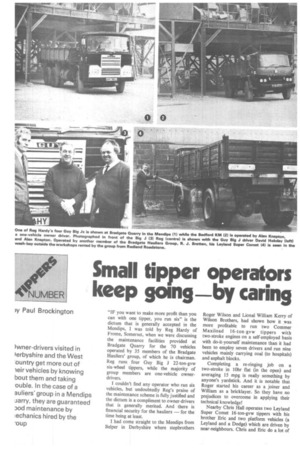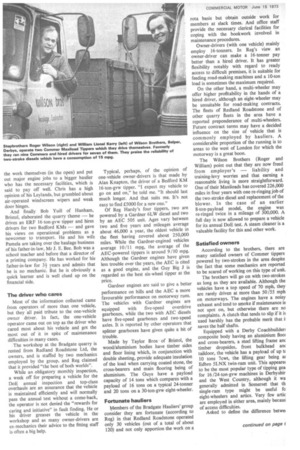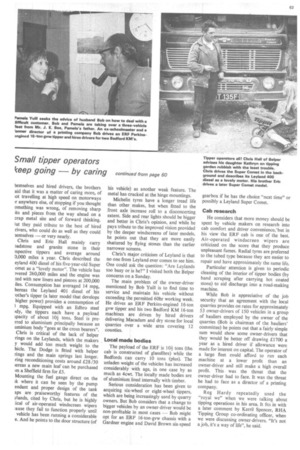Small tipper operators keep gang by caring
Page 61

Page 62

Page 65

If you've noticed an error in this article please click here to report it so we can fix it.
/wner-drivers visited in /erbyshire and the West :ountry get more out of leir vehicles by knowing bout them and taking 'ouble. In the case of a auliers' group in a Mendips uarry, they are guaranteed Dod maintenance by iechanics hired by the -o up
"IF you want to make more profit than you can with one tipper, you run six" is the dictum that is generally accepted in the Mendips, I was told by Reg Hardy of Frome, Somerset, when we were discussing the maintenance facilities provided at Bradgate Quarry for the 70 vehicles operated by 35 members of the Bradgate Hauliers' group, of which he is chairman. Reg runs four Guy Big .1 22-ton-gvw six-wheel tippers, while the majority of group members are one-vehicle ownerdrivers.
I couldn't find any operator who ran six vehicles, but undoubtedly Reg's praise of the maintenance scheme is fully justified and the dictum is a compliment to owner-drivers that is generally merited. And there is financial security for the hauliers — for the time being at least.
I had come straight to the Mendips from Belper in Derbyshire where stepbrothers Roger Wilson and Lional William Kerry of Wilson Brothers, had shown how it was more profitable to run two Commer Maxiload 16-ton-gvw tippers with two-stroke engines on a self-employed basis with do-it-yourself maintenance than it had been to employ seven drivers and run nine vehicles mainly carrying coal (to hospitals) and asphalt blocks.
Completing a re-ringing job on a two-stroke in 10hr flat (in the open) and averaging 15 mpg is really something by anyone's yardstick. And it is notable that Roger started his career as a joiner and William as a bricklayer. So they have no prejudices to overcome in applying their technical knowledge!
Nearby Chris Hall operates two Leyland Super Comet 16-ton-gvw tippers with his brother Eric and two platform vehicles (a Leyland and a Dodge) which are driven by near-neighbours. Chris and Eric do a lot of the work themselves (in the open) and put out major engine jobs to a bigger haulier who has the necessary facilities, which is said to pay off well. Chris has a high opinion of his Leyl ands, but grumbled about air-operated windscreen wipers and weak door hinges.
And finally Bob Yuill of Hanham, Bristol, elaborated the quarry theme — he drives an ERF 16-ton-gvw tipper and hires drivers for two Bedford KMs — and gave his views on operational problems as a newcomer to transport. He and his wife Pamela are taking over the haulage business of his father-in-law, Mr J. E. Bee. Bob was a school teacher and before that a director of a printing company. He has worked for his father-in-law for 3-1years and admits that he is no mechanic. But he is obviously a quick learner and is well clued up on the financial side.
The driver who cares Most of the information collected came from operators of more than one vehicle, but they all paid tribute to the one-vehicle owner driver. In fact, the one-vehicle operator came out on top as the driver who cared most about his vehicle and got the most out of it in spite of maintenance difficulties in many cases.
The workshop at the Bradgate quarry is rented from Redland Roadstone Ltd, the owners, and is staffed by two mechanics employed by the group, and Reg claimed that it provided "the best of both worlds".
While an obligatory monthly inspection, a week off for preparing a vehicle for the DoE annual inspection and top-class overhauls are an assurance that the vehicle is maintained efficiently and will normally pass the annual test without a come-back, the operator is not denied the "rewards for caring and initiative" in fault finding. He or his driver greases the vehicle in the workshop and as many owner-drivers are ex-mechanics their advice to the fitting staff is often a big help. Typical, perhaps. of the opinion of one-vehicle owner-drivers is that made by Alan Knapton, the driver of a Bedford KM 16-ton-gvw tipper. "I expect my vehicle to go on and on," he told me. "It should last much longer. And that suits me. It's not easy to find £5000 for a new one."
Of Reg Hardy's four tippers, two are powered by a Gardner 6LW diesel and two by an AEC 505 unit. Ages vary between two and five years and mileages average about 46,000 a year, the oldest vehicle in the fleet having covered about 250,000 miles. While the Gardner-engined vehicles average 10 /11 mpg, the average of the AEC-powered tippers is around 9/10 mpg. Although the Gardner engines have given less trouble over the years, the AEC is cited as a good engine, and the Guy Big J is regarded as the best six-wheel tipper at the price.
Gardner engines are said to give a better performance on hills and the AEC a more favourable performance on motorway runs. The vehicles with Gardner engines are equipped with five-speed overdrive gearboxes, while the two with AEC diesels have five-speed gearboxes and two-speed axles. It is reported by other operators that splitter gearboxes have given quite a bit of trouble.
Made by Taylor Bros of Bristol, the wood/aluminium bodies have timber sides and floor lining which, in conjunction with double sheeting, provide adequate insulation of the load when carrying coated stone, the cross-bearers and main flooring being of aluminium. The Guys have a payload capacity of 14 tons which compares with a payload of 16 tons on a typical 24-tonner and 20 tons on a 30-ton-gvw eight-wheeler.
Fortunate hauliers Members of the Bradgate Hauliers' group consider they are fortunate (according to Reg) in that Redland Roadstone operated only 30 vehicles (out of a total of about 120) and not only apportion the work on a rota basis but obtain outside work for members at slack times. And office staff provide the necessary clerical facilities for coping with the bookwork involved in maintenance procedures.
Owner-drivers (with one vehicle) mainly employ 16-tonners. In Reg's view an owner-driver can make a 16-tonner pay better than a hired driver. It has greater flexibility notably with regard to ready access to difficult premises, it is suitable for feeding road-making machines and a 10-ton load is sometimes the maximum required.
On the other hand, a multi-wheeler may offer higher profitability in the hands of a hired driver, although an eight-wheeler may be unsuitable for road-making contracts. The fleets of Redland Roadstone and of other quarry fleets in the area have a reported preponderance of multi-wheelers. Future contract terms may have a decided influence on the size of vehicle that is commonly employed by hauliers. A considerable proportion of the running is to areas to the west of London for which the motorway is a great boon.
The Wilson Brothers (Roger and William) point out that they are now freed from employer's -liability and training-levy worries and that earning a reasonable living is more straightforward. One of their Maxiloads has covered 226,000 miles in four years with one re-ringing job of the two-stroke diesel and replacement of the blower. In the case of an earlier 8-ton-payload model, the engine was re-ringed twice in a mileage of 300,000. A full day is now allowed to prepare a vehicle for its annual DoE test. A steam cleaner is a valuable facility for this and other work.
Satisfied owners According to the brothers, there are many satisfied owners of Commer tippers powered by two-strokes in the area despite the fact that some mechanics are reported to be scared of working on this type of unit.
The brothers will go on with two-strokes as long as they are available. Although the vehicles have a top speed of 70 mph, they are rarely driven at more than 50/55 mph on motorways. The engines have a noisy exhaust and tend to smoke if maintenance is not spot on, but otherwise there are no complaints. A clutch that tends to slip if it i5 used harshly has the probable merit that i saves the half shafts.
Equipped with a Derby Coachbuilden composite body having an aluminium flooi and cross-bearers, a steel lifting frame anc timber dropsides, front bulkhead am taildoor, the vehicle has a payload of up ti 10 tons 7cwt, the lifting gear being ai Edbro 5LNX twin-ram unit. This appeare■ to be the most popular type of tipping gea for 16 /24-ton-gvw machines in Derbyshir and the West Country, although it wa generally admitted in Somerset that th single-ram type might be useful fa eight-wheelers and artics. Very few artic are employed in either area, mainly becaus of access difficulties.
Asked to define the difference betwo
hemselves and hired drivers, the brothers aid that it was a matter of caring more, of tot travelling at high speed on motorways or anywhere else, of stopping if you thought omething was wrong, of removing sharp tits and pieces from the way ahead on a crap metal site and of forward thinking. hit they paid tribute to the best of hired rivers, who could do as well as they could 3emselves — or very nearly. Chris and Eric Hall mainly carry mdstone and granite stone in their :.spective tippers and average around 0,000 miles a year. Chris described the eyland 400 diesel of his five-year-old Super omet as a "lovely motor". The vehicle has avered 260,000 miles and the engine was :ted with new liners and pistons at 200,000 iles. Consumption has averaged 14 mpg, hereas the Leyland 401 diesel of his .other's tipper (a later model that develops higher power) provides a consumption of 1 mpg. Equipped with an Edbro steel )dy, the tippers each have a payload ipacity of about 10+ tons. Steel is prerred to aluminium principally because an urninium body "goes at the cross bearers". Chris is critical of the lack of helper rings on the Leylands, which the makers y would add too much weight to the hick. The Dodge is fitted with helper rings and the main springs last longer. ring reconditioning costs around £28 /30 iereas a new main leaf can be purchased an a Sheffield firm for £5.
Mounting the fuel gauge direct on the ik where it can be seen by the pump endant and proper design of the tank aps are praiseworthy features of the viands, cited by Chris, but he is highly :lad of air-operated windscreen wipers !ause they fail to function properly until n vehicle has been running a considerable o e. And he points to the door structure (of his vehicle) as another weak feature. The metal has cracked at the hinge mountings.
Michelin tyres have a longer tread life than other makes, but when fitted to the front axle increase roll to a disconcerting extent. Side and rear lights should be bigger and better in Chris's opinion, and while he pays tribute to the improved vision provided by the deeper windscreens of later models, he points out that they are more easily shattered by flying stones than the earlier narrower screens.
Chris's major criticism of Leyland is that no one from Leyland ever comes to see him. One could ask the question: "Are Leylands too busy or is he?" I visited both the Belper concerns on a Sunday.
The main problem of the owner-driver mentioned by Bob Yuill is to find time to service and maintain his vehicle without exceeding the permitted 60hr working week. He drives an ERF Perkins-engined 16-ton gvw tipper and his two Bedford KM 16-ton machines are driven by hired drivers delivering Macadam and dry stone for local quarries over a wide area covering 12 counties.
Local made bodies The payload of the ERF is 10+ tons (the, cab is constructed of glassfibre) while the Bedford& can carry 10 tons (plus). The unladen weight of the vehicles has increased considerably with age, in one case by as much as 4cwt. The locally made bodies are of aluminium lined internally with timber. Serious consideration has been given to acquiring six-wheel or eight-wheel tippers, which are being increasingly used by quarry owners. But Bob considers that a change to bigger vehicles by an owner-driver would be on-profitable in most cases — Bob might pt for an ERF 16-ton-gvw chassis with a Gardner engine and David Brown six-speed gearbox if he has the choice "next time" or possibly a Leyland Super Comet.
Cab research He considers that more money should be spent by vehicle makers on research into cab comfort and driver convenience;but in his view the ERF cab is one of the best. Air-operated windscreen wipers are criticized on the score that they produce unpleasant fumes. Radial tyres are preferred to the tubed type because they are easier to repair and have approximately the same life.
Particular attention is given to periodic cleaning of the interior of tipper bodies (by hand scraping after carrying hot coated stone) to aid discharge into a road-making machine.
While Bob is appreciative of the job security that an agreement with the local quarries provides on rates for approximately 53 owner-drivers of 150 vehicles in a group of hauliers employed by the owner of the quarries (Bob is chairman of the hauliers' committee) he points out that a fairly simple sum would show some owner-drivers that they would be better off drawing £1700 a year as a hired driver if allowance were made for interest on capital. The operator of a large fleet could afford to run each machine at a lower profit than an owner-driver and still make a high overall profit. This was the threat that the owner-driver had to face. It was the threat he had to face as a director of a printing company.
Reg Hardy repeatedly used the "royal we" when we were talking about tipping operations in his area. It fits in with a later comment by Kerril Spencer, RHA Tipping Group co-ordinating officer, when we were discussing owner-drivers. "It's not a job, it's a way of life", he said.












































































































































